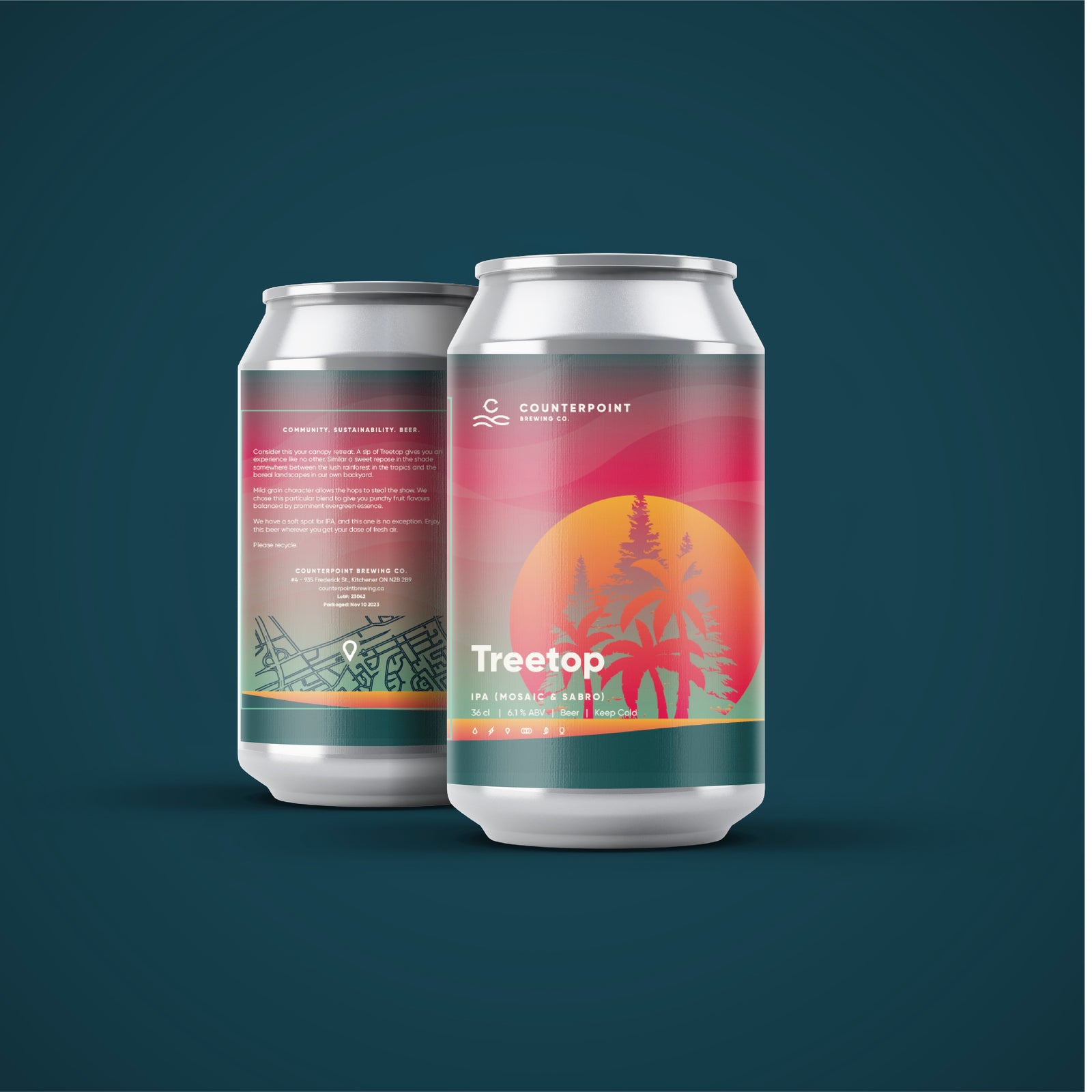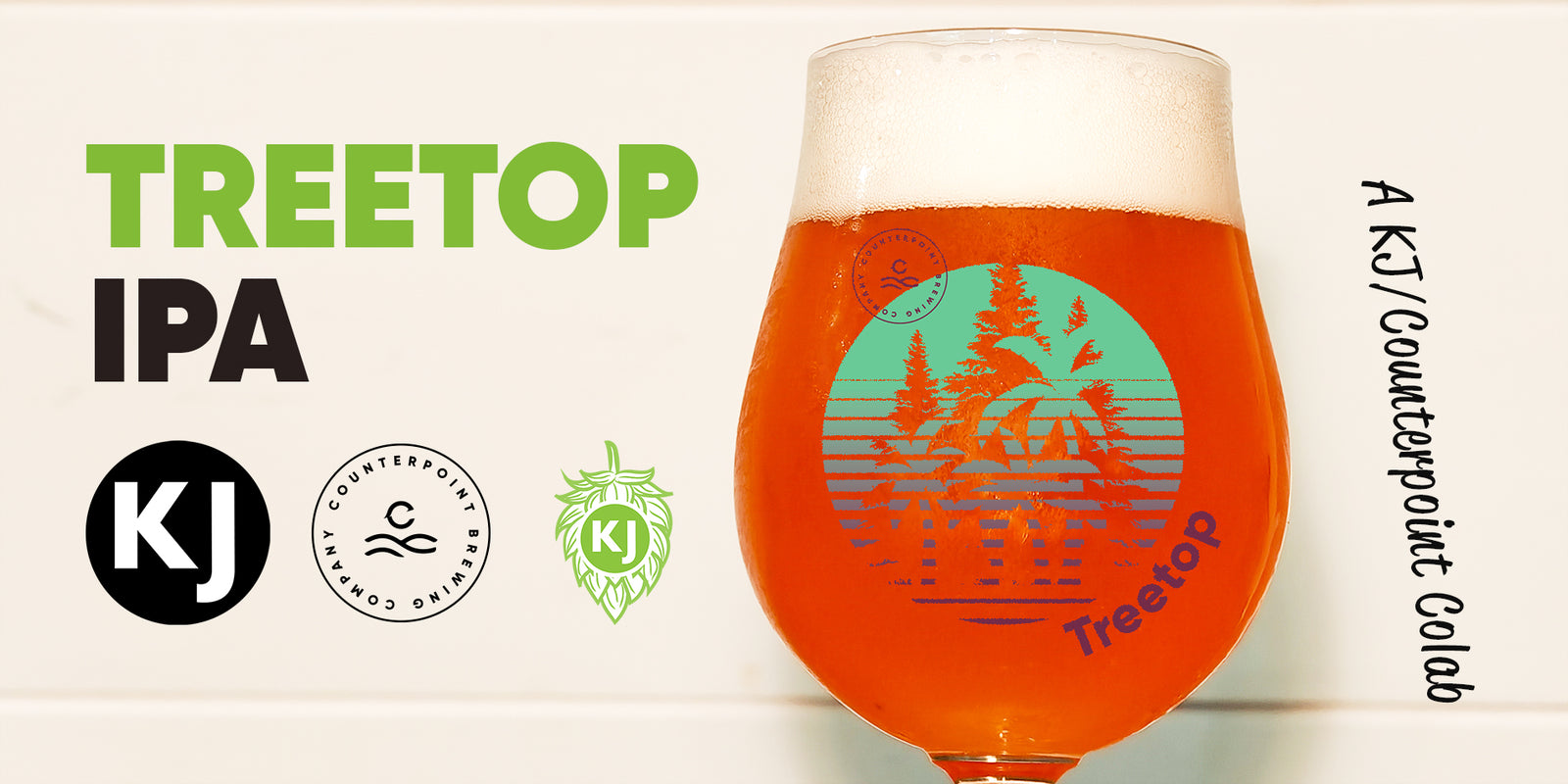


Sold out
Treetop IPA Recipe
$55.99
IPA – 5.5 Gal - OG 1.059 – FG 1.010 – ABV 6.0% - IBU 37 – SRM 38
We’re proud to be working with our friends at Counterpoint Brewing Company for this beer! This is their famous Treetop IPA recipe. Graeme over at CPC was happy to share his recipe with us. It is their signature IPA with a mild malt backbone and a hoppy punch thanks to Sabro and Mosaic (or El Dorado depending on availability) hops with tropical and evergreen notes. Why not brew this recipe and head over to CPC to buy a can – then do a blind taste test and see how close you got!?
Ingredients and Instructions are listed below
Ingredients
Grains
- Rahr Pilsner x 8.6lbs
- Flaked Oats x 2.2lbs
- Wheat Malt x 1lb
- Wheat Malt x 2lbs
- Acidulated x 0.2lbs
Hops
Boil Schedule (minutes)
- Magnum 1/3 ounce @ 60 mins
- Sabro 1 ounce @ 0 minutes
- Mosaic 1 ounce @ 0 minutes
- Sabro 3 ounce Dry Hop @ 3 days prior to packaging
- Mosaic 4 ounce Dry Hop @ 3 days prior to packaging
Yeast
- Escarpment Labs House Ale Yeast
Extras (Must be purchased separately)
- Gypsum - 3/4 teaspoon at mash in
- Irish Moss - 1 tsp for last 15 minutes of boil
- DME/Dextrose - 150g at bottling for priming

Instructions
(please note, most of these pictures are from other beers - but the beauty of brewing is that the majority of steps for brewing beers are very similar, and these photos are equally instructive for any style of beer.)
Printable InstructionsImportant Tips on Brewing
- Be extra cautious when it comes to cleaning! Once you have stopped boiling your wort everything that gets in contact with the beer MUST be sanitary.
- The temperature of your mash is ABSOLUTELY CRITICAL. Not being in the 150-155f range can drastically affect your beer. Make sure you correct the temperature ASAP once all the grain has been added to the mash.
- Always let your beer ferment for 10 days! Do not disturb it, do not open the lid. It is absolutely natural for the airlock to stop bubbling after a few days, it is still fermenting though.
- Oxidization: Airspace is always something to consider. When undergoing primary fermentation airspace is needed so that the beer can bubble up and ferment vigoursley without leaking out of the container. The fermentation creates a layer of CO2 that remains in the pail due to the airlock. Once primary fermentation is over, and the lid has been opened, the layer of CO2 dissipates, and oxygen replaces it. At this point airspace can ruin your beer. When racking into carboys make sure they are filled to the top, or you blast CO2 inside to prevent oxidization. Ask us for details on this!
- Before bottling, make sure you use a priming calculator (many can be found online) to verify the amount of sugar that needs to be added.
Mashing -> Converting the Grain into a Fermentable Liquid
- Bring 6 gallons of water in your brew pot to 155°F. This is our strike temperature. Turn off the heat to the pot.
- If you are using standard Guelph tap water, add ¾ tsp of GYPSUM to the water. This raised the sulfates in the water which brings out more hop aroma, and crisper hop bitterness.
- Wrap the muslin/nylon bag around the brew pot and slowly pour all the milled grains into the bag. Stir them in while adding to prevent clumps. The addition of grain should drop the temperature down to 150-155°F.
- We want to mash the grain at 154°F for 60 minutes. It is very important to hold the temperature at 154°F. If the temperature rises above 155°F it hurts the fermentation, or if it dips below 149°F it can lead to a thinner tasting beer.
- The first 15-30 minutes are essential for the success of your brew. The temperature HAS TO BE IN THE RANGE OF 150-155°F. Sometimes adding the grain to the strike water does not lower the temperature enough, in this case add a little bit of cold water to bring the temperature down. Cover the pot with your lid and let it sit.
- Most brew pots will be able to maintain 154°F without adding heat for 20 minutes, we recommend checking the temperature every 15 minutes, and if it drops add more heat to bring it up. We recommend opening the lid and using a thermometer in the liquid.
- After 60 minutes, bring the temperature of the mashing grain up to 170°F and hold for 10 minutes. This is our mash out.
- Time to remove the grain. Lift the bag full of grain out of the brew pot. Let the liquid in the bag dribble into your wort. Once that is done, put the bag inside of a brewing pail, or another empty pot. There will be about 4 gallons of wort in the brew pot, we need to get it to 6 gallons before we can begin the next stage.
- Run warm water through the grains in the bag, aim for 170°f – let it run through the grains and add to the brew pot. Add until you reach 6 gallons. PSA: It is natural to think that the grains need to be squeezed to get all of the liquid out of them, DO NOT DO THIS. Aggressively squeezing the grains will lead to tannin extraction and a doughy taste in your beer. Lightly pressing the bag is fine, but do not try to squeeze every last drop out.
Boiling -> Sterilizing the Wort Time
- Bring 6 gallons of your wort to a rolling boil, and let it boil for 5 minutes, this is called the hot break.
- Add .33 of an ounce of Magnum hops to the boil (If you like an even more bitter beer you could instead make it a /12oz addition or even a full ounce addition). Start a 60-minute timer. Keep the wort boiling (212°f) and uncovered.
- With 15 minutes left in the timer add 1 tsp of Irish moss to the boil. If you have a wort chiller, we recommend adding it now.
- When the timer goes off, turn off the heat, and then add 1 ounce of Mosaic and Sabro to the wort.
- Now it’s time to cool the beer down to 75°f (20-25°c) as quickly as possible.
- We love using a wort chiller for this, it can get the beer down to temperature in 20-30 minutes. Otherwise, you can immerse the brew pot in an ice bath or wait it out. The longer it takes, the greater the risk of infection.
Fermentation -> Turning the Wort into Beer
- After the boil is done it is time to be extra careful in regard to sanitation. We recommend using a no-rinse sanitizer called Starsan. Mix ¼ tsp of it with water in a 500ml spray bottle. Before we touch any part of the beer, we spray it with Starsan.
- Transfer the cooled wort into your fermenting pail or carboy. Run it though a strainer to catch any hop or grain residue.
- It is also good time to take a hydrometer reading. It should be around 1.059 give or take a few points.
- Make sure the wort has been cooled to at least 25c!!! Adding yeast at a higher temperature will likely kill it.
- Once the beer is in the fermenter, add 1 package of Escarpment Lab’s House Ale yeast.
- Put the bung and airlock in the hole (make sure there is water filled up to the line in the airlock). If using a pail, make sure the lid is sealed tight. Put the pail in a room that is in the range of 19-22°c.
- This fermentation should take between 10-14 days to complete. At first you will see a lot of bubbles coming out of the airlock, by day 5 (or maybe even sooner) the bubbles will slow down. DO NOT open the lid. Leave the beer be.
- DRY HOP TIMING. Time to plan for the dry hop. This recipe calls for 3 days of dry hopping before bottling/kegging. Which means, you should plan for when you want to bottle or keg this beer and dry hop 3 days before that. The beer can safely sit in the fermenter for up to 20 days – its most important to know when you will have the time to bottle the beer.
- For example, if you have time to bottle the beer on day 15 of the fermentation, do the dry hop on day 12.
- DRY HOP Addition: When you have decided on the time to dry hop. Quickly add 3 ounces of Sabro and 4 ounces of Mosaic.
- When you are adding hops to your fermenter, you need to prevent excess oxygen getting into your beer. We recommend quickly removing the bung or airlock and adding the hops. If it takes longer than 10-15 seconds, then it would be a good idea to get more CO2 inside the fermenter. If you have CO2 available, spray some from your tank into the fermenter. If you don’t, then put a mixture of 100g of dextrose and boiled water into the fermenter. This will initiate a mini fermentation that will expel any oxygen that might have gotten into the vessel while dry hopping.
- After the 3 days of dry hopping are complete, it is time to move on to the bottling stage.
- When you are ready to bottle, the first thing to do is take a hydrometer reading. It should be between 1.009-1.013
- Unless you are kegging, we recommend skipping secondary and going straight to the bottling process. Clarification can occur in the bottle rather than in a carboy, and the risk of oxidization is greatly reduced.
Bottling -> We’re getting close to Beer Time now
- Rack the now fermented beer into a bucket.
- At the same time, mix the priming sugar with 300ml of boiling water and add to the beer. Stir it in VERY gently.
- Rack the beer into your bottles or growlers. Then, let them sit for 2-3 weeks at room temperature. Chill and enjoy!
- If you are kegging, rack the beer into the keg and put CO2 on it right away. 2 days at 30 PSI, followed by a 10 PSI taste test. If it is not carbonated enough yet, another day at 20 PSI before returning to 10. There are faster methods of carbonating a keg including using a Quick Carb, or by shaking the keg while attached to CO2 (ask us for details on that method)







